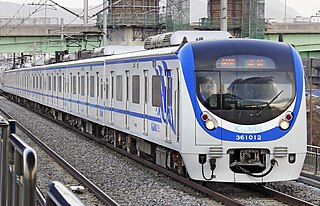
The Gyeongchun Line is a regional rail line between Seoul and Chuncheon, South Korea, operated by Korail. Its name is derived from Gyeong and Chuncheon. It was completely reconstructed in the 2000s. Service on it has operated between Sangbong station on the Jungang Line in eastern Seoul and Chuncheon station, as part of the Seoul Metropolitan Subway system, since December 21, 2010. A class of regional rail service named ITX-Cheongchun began operations on February 28, 2012, linking Chuncheon to Cheongnyangni and Yongsan Stations.
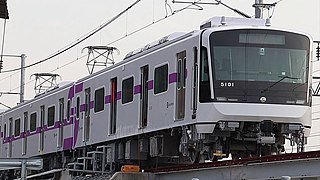
Seoul Subway Line 5 of the Seoul Metropolitan Subway, dubbed the purple line, is a long line crossing from west to the east across the Seoul National Capital Area, South Korea. It is one of two subway lines in Seoul to cross under the Han River, which is done at two points. The main line runs through to Hanam Geomdansan Station while the branch line from Gangdong Station terminates at Macheon Station. In 2019, Line 5 carried an annual ridership of 334 million or about 915,000 passengers per day.

Seoul Subway Line 4 of the Seoul Metropolitan Subway is a long line crossing from the southwest to the northeast across the Seoul National Capital Area. The central section in Seoul City is operated by Seoul Metro with some trains offering through service to Korail's Ansan and Gwacheon Lines. The southern terminus (Oido) is in Jeongwang 4-dong, Siheung City, and the northern terminus (Jinjeop) is in Jinjeop-eup, Namyangju-si, Gyeonggi-do; the newly built northern section is correspondingly owned by a company owned by Namyangju-si, with operations contracted to Seoul Metro. In 2022, the Seoul Metro operated section had an annual ridership of 219,587,000 or about 601,608 passengers per day.

Seoul Metro Corporation (Korean: 서울메트로) was a municipal-owned corporation owned by the Seoul Metropolitan Government. Established in 1970, it was, with Seoul Metropolitan Rapid Transit Corporation and Korail, one of the major operators of Seoul Metropolitan Subway. The company merged with Seoul Metropolitan Rapid Transit Corporation in 2017.

Seoul Metropolitan Rapid Transit Corporation (SMRT) was established in 1994 to operate the Seoul Subway lines 5, 6, 7, 8 in Seoul, South Korea.

Oksu Station is a railway interchange station on the Line 3 and the Gyeongui–Jungang Line. It was opened in 1985 and is located near the confluence of the Han and Jungnang Rivers.

Anguk station, also known as Hyundai E & C station (Korean: 현대건설), is a subway station on the Line 3 of the Seoul Metropolitan Subway. The station is located in the Anguk neighborhood of Jongno District, Seoul and is the nearest subway station to the Insa and Samcheong neighborhoods. The station is also near the ancient royal residence of Unhyeongung.

Seoul Subway Line 9, operated by Seoul Line9 Operation, is a subway line in Seoul, part of the Seoul Metropolitan Subway. The line runs east from Gaehwa station or Gimpo International Airport station along the south bank of the Han River towards VHS Medical Center in Gangdong. In 2019, Line 9 had an annual ridership of 225 million or about 616,000 people per day.

Yangjae Station is a station on the Seoul Subway Line 3 and Shinbundang Line. It was the southern terminus of Line 3 until October 30, 1993, when the line was extended to Suseo station, and it became a transfer station with the Shinbundang Line on October 28, 2011. It is located in Yangjae-dong, Seocho and Gangnam District, Seoul.
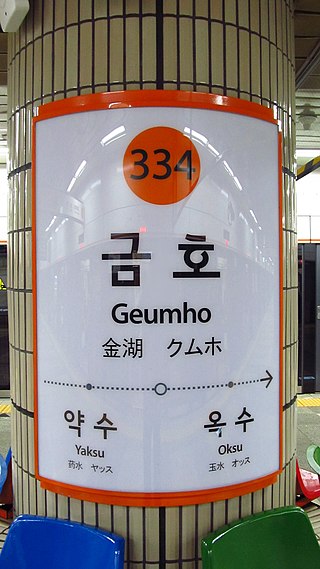
Geumho Station (Korean: 금호역) is a station on the Seoul Subway Line 3 in Seongdong-gu, Seoul, South Korea. The name of the station literally means "golden lake", although there is no lake to be found today in the neighborhood of this station. The short piece of road under which this station is built is situated between two consecutive road tunnels nearby.

Daechi Station (Korean: 대치역) is a station on the Seoul Subway Line 3. It is located in Daechi-dong, Gangnam-gu, Seoul. It was named after a former village in the area, Hanti (한티), as Daechi is the Chinese reading of the hanja. The name of the station is Chinese characters, meaning "big hill."

Sinsa station is a station on the Seoul Subway Line 3 and the Shinbundang Line. It is located in Sinsa-dong, Gangnam-gu and Jamwon-dong, Seocho-gu, Seoul. It will serve as the northern terminus of the Wirye–Sinsa Line when it is opened in 2025.
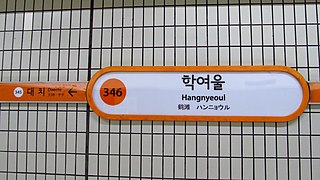
Hangnyeoul Station (Korean: 학여울역) is a station on the Seoul Subway Line 3 in Gangnam-gu, Seoul. The only exit of this station is connected to SETEC. This station has the least ridership of all Line 3 stations in Seoul.

SuseoStation is a railroad station on the Suin–Bundang Line and Line 3 of the Seoul Metropolitan Subway. The station is in the Suseo neighborhood of the Gangnam District in Seoul, South Korea. Prior to the Line 3 extension to Ogeum station in 2010, Suseo Station was the southeastern terminus of Line 3. Along with Yangjae station, Suseo Station serves as an important transfer point between Line 3 and buses from/to southern cities such as Seongnam, Yongin, and Suwon.

Nambu Bus Terminal Station is a subway station on the Seoul Subway Line 3 in Seocho-gu, Seoul. Its substation name is Seoul Arts Center. As its name indicates, it serves the nearby Nambu Bus Terminal. It is also the closest station to the Seoul Arts Center, located about a half-mile southwest of here. When this line opened, this station was called the Cargo Truck Terminal.

Danggogae Station (Korean: 당고개역) is a station on Line 4 of the Seoul Metropolitan Subway network. It was the northern terminus of Line 4, until 19 March 2022, when the line was extended to Jinjeop. It is an elevated station. The name of the subway station comes from its local name. Regional names refer to the pass that travelers carried over because of wild animals.
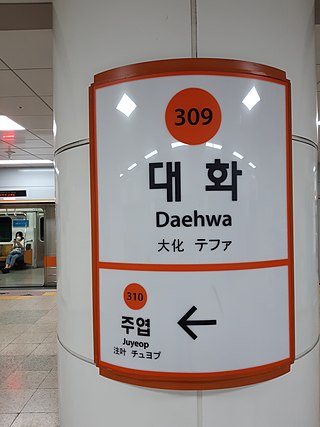
Daehwa Station is an underground metro station on the Seoul Subway Line 3, operating as an extension of Line 3 of the Seoul Subway, in Daehwa-dong, Ilsanseo-gu, Goyang, South Korea. The station is Line 3's northwestern terminus and its 6 exits offer access to, among other places, KINTEX. Travel time from Daehwa to Seoul Station, changing to Line 1 at Jongno 3(sam)-ga, is 1 hour and 2 minutes, while traveling the full length of Line 3 to Ogeum takes 1 hour and 36 minutes.
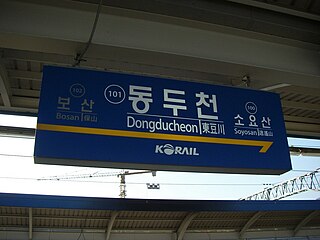
Dongducheon Station is a metro station located in Dongducheon, South Korea. Seoul Subway Line 1 serves this station, and it is the terminus station for Gyeongwon Line express trains. Camp Casey, a U.S. Army military base, is located nearby.

Oido station is a subway station on Seoul Subway Line 4 and the Suin–Bundang Line in Siheung, South Korea. It is the current southwestern terminus of Seoul Subway Line 4 located almost 30 kilometers southwest of Seoul, connecting Oido to other parts of Korea. A commuter rail trip between this station and Seoul Station takes over an hour, and a train servicing depot is located nearby. The name of the station was decided by the surrounding area Oido island.

National Police Hospital is a station on Line 3 of the Seoul Metropolitan Subway located in Songpa-gu, Seoul. On February 18, 2010, it was opened as part of an eastward extension of Line 3.






















